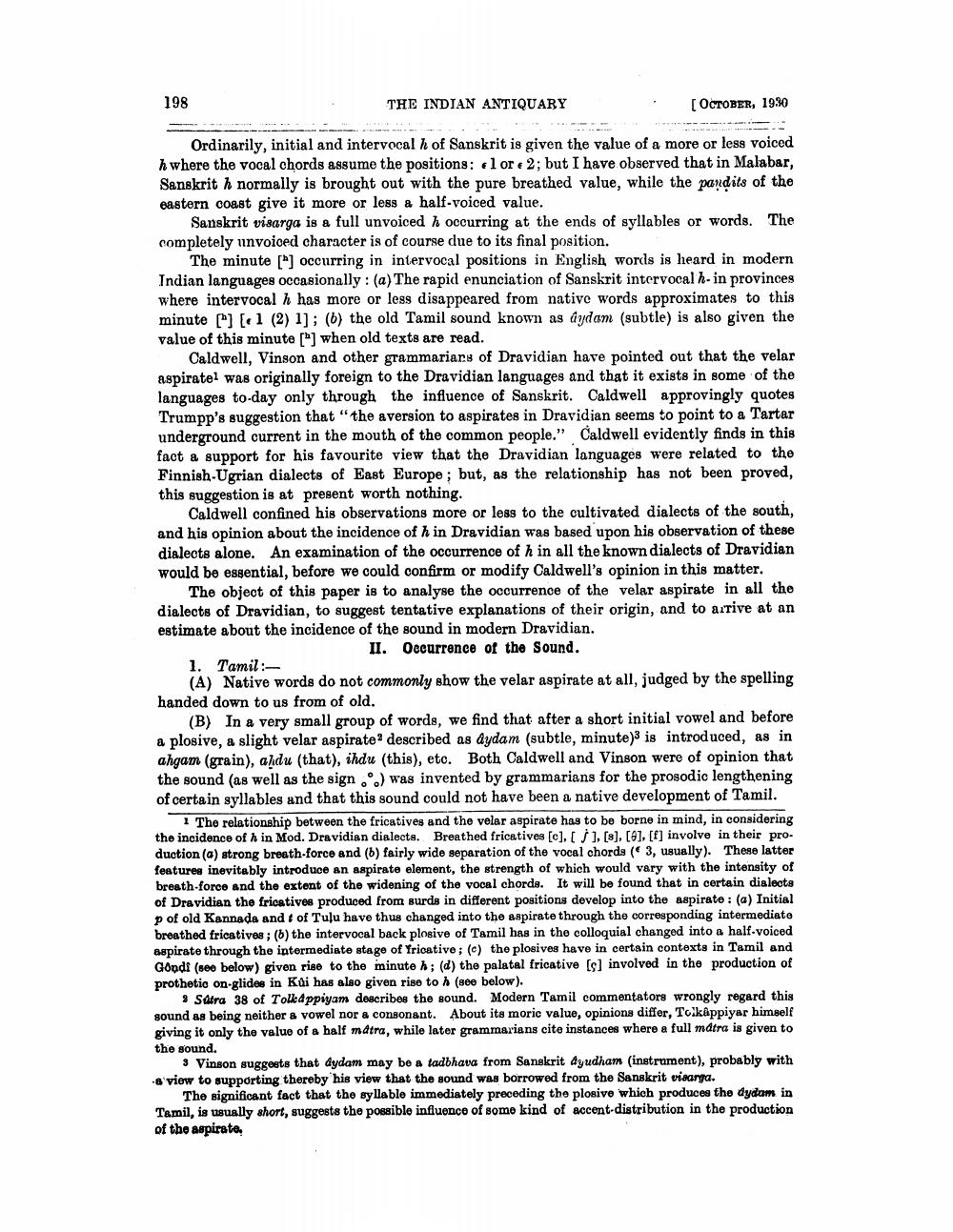________________
198
THE INDIAN ANTIQUARY
.
[OCTOBER, 1930
Ordinarily, initial and intervocal h of Sanskrit is given the value of a more or less voiced h where the vocal chords assume the positions: el or < 2; but I have observed that in Malabar, Sanskrit h normally is brought out with the pure breathed value, while the pandits of the eastern coast give it more or less a half-voiced value.
Sanskrit visarga is a full unvoiced h occurring at the ends of syllables or words. The completely unvoioed character is of course due to its final position.
The minute [] occurring in intervocal positions in English words is heard in modern Indian languages occasionally : (a) The rapid enunciation of Sanskrit intervocal h-in provinces where intervocal h has more or less disappeared from native words approximates to this minute 1 (2) 1]; (b) the old Tamil sound known as dydam (subtle) is also given the value of this minute [] when old texts are read.
Caldwell, Vinson and other grammariars of Dravidian have pointed out that the velar aspiratel was originally foreign to the Dravidian languages and that it exists in some of the languages to-day only through the influence of Sanskrit. Caldwell approvingly quotes Trumpp's suggestion that "the aversion to aspirates in Dravidian seems to point to a Tartar underground current in the mouth of the common people." Caldwell evidently finds in this fact a support for his favourite view that the Dravidian languages were related to the Finnish-Ugrian dialects of East Europe ; but, as the relationship has not been proved, this suggestion is at present worth nothing.
Caldwell confined his observations more or less to the cultivated dialects of the south, and his opinion about the incidence of h in Dravidian was based upon his observation of these dialects alone. An examination of the occurrence of h in all the known dialects of Dravidian would be esgential, before we could confirm or modify Caldwell's opinion in this matter.
The object of this paper is to analyse the occurrence of the velar aspirate in all the dialects of Dravidian, to suggest tentative explanations of their origin, and to arrive at an estimate about the incidence of the sound in modern Dravidian.
II. Occurrence of the Sound. 1. Tamil:
(A) Native words do not commonly show the velar aspirate at all, judged by the spelling handed down to us from of old.
(B) In a very small group of words, we find that after a short initial vowel and before a plosive, a slight velar aspirate described as dydam (subtle, minute) is introduced, as in ahgam (grain), aldu (that), ihdu (this), etc. Both Caldwell and Vinson were of opinion that the sound (as well as the sign ) was invented by grammarians for the prosodic lengthening of certain syllables and that this sound could not have been a native development of Tamil.
1 The relationship between the fricatives and the velar aspirate has to be borne in mind, in considering the incidence of h in Mod. Dravidian dialects. Breathed fricatives (c], [ ], [8], [], [f] involve in their production (a) strong breath-force and (b) fairly wide separation of the vocal chords (€ 3, usually). These latter features inevitably introduce an aspirate element, the strength of which would vary with the intensity of breath-force and the extent of the widening of the vocal chords. It will be found that in certain dialects of Dravidian the fricativos produced from surds in different positions develop into the aspirato: (a) Initial p of old Kannada and 1 of Tulu have thus changed into the aspirate through the corresponding intermediato breathed fricatives; (b) the intervocal back plosive of Tamil has in the colloquial changed into a half-voiced aspirate through the intermediate stage of Yricative; (c) the plosives have in certain contexts in Tamil and Gondi (see below) given rise to the minute h; (d) the palatal fricative (s] involved in the production of prothetic on-glides in Kui has also given riso to h (see below).
Satra 38 of Tolled ppiyam describes the sound. Modern Tamil commentators wrongly regard this sound as being neither & vowel nor & consonant. About its moric value, opinions differ, Toikappiyar himself giving it only the value of a half matra, while later grammarians cite instances where a full matra is given to the sound.
3 Vinson suggests that dydam may be a tadbhava from Sanskrit dyudham (instrument), probably with 8 view to supporting thereby his view that the sound was borrowed from the Sanskrit visarga.
The significant fact that the syllable immediately preceding the plosive which produces the dydam in Tamil, is usually short, suggests the possible influence of some kind of accent-distribution in the production of the aspirate.




